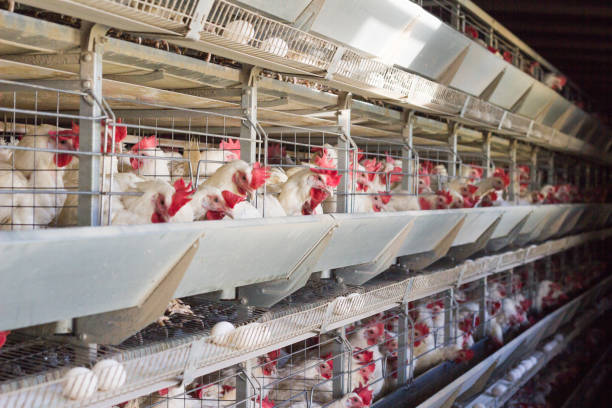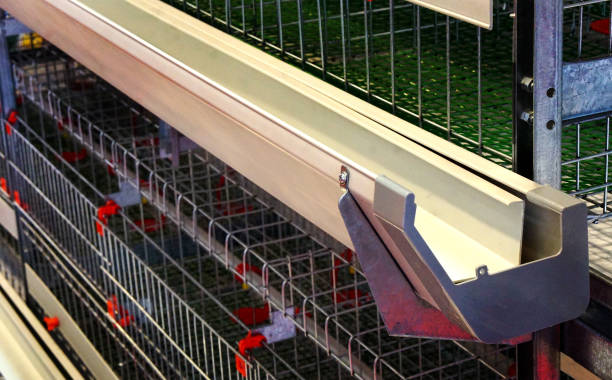
Affordable Cages for a 50,000 Bird Chicken Farm in Indonesia
Affordable Cages for a 50,000 Bird Chicken Farm in Indonesia
Setting up a chicken farm, especially one housing a substantial flock of 50,000 birds, in a place like Indonesia requires careful planning and strategic investment. One of the most significant investments you’ll make is in the housing system – specifically, the cages. Finding affordable yet reliable cages that meet the specific needs of your farm is crucial for maximizing productivity and profitability. This article delves into the considerations for choosing affordable cages for a large-scale chicken farm in Indonesia, focusing on key aspects like cage types, material quality, environmental factors, and how to balance cost-effectiveness with long-term durability.
Understanding the Indonesian Poultry Landscape
Indonesia presents both unique opportunities and challenges for poultry farming. The demand for chicken meat and eggs is consistently high, driven by a large and growing population with an appetite for affordable protein sources. However, the tropical climate, varying terrain, and specific regulations all influence the design and selection of suitable chicken cages. Before diving into cage options, it’s vital to understand the local market dynamics, prevalent breeds, disease challenges, and resource availability in your specific region of Indonesia.
Cage Types: Layer vs. Broiler
The first and most crucial decision is whether you’re raising layer chickens (for egg production) or broiler chickens (for meat production). Each type requires a distinct cage design optimized for their respective needs.
Layer Cages: Layer cages, also known as battery cages, are designed to house multiple hens in a confined space. They are typically arranged in tiers to maximize space utilization within the poultry house. Key features of layer cages include:
Sloped floors: These facilitate egg collection, as eggs roll gently forward for easy harvesting.
Feed and water troughs: Designed for easy access and minimal wastage.
Adequate ventilation: Crucial for maintaining air quality and preventing disease.
Broiler Cages: Broiler cages are designed to accommodate the rapid growth of meat chickens. They are generally larger and more spacious than layer cages, allowing the birds to move around comfortably and preventing overcrowding, which can lead to stress and disease. Important features include:
Easy access for feeding and watering: Ensures the birds have constant access to essential nutrients and hydration.
Solid or mesh flooring: Mesh flooring allows for better manure management, while solid flooring can provide enhanced comfort.
Robust construction: To withstand the weight and activity of growing broilers.
Material Matters: Choosing the Right Construction Material
The material used in constructing the cages significantly impacts their durability, hygiene, and, of course, cost. Common materials include:

Galvanized Steel: This is the most popular choice due to its excellent strength, corrosion resistance, and relatively low cost. Galvanization involves coating the steel with a layer of zinc, which protects it from rust and extends its lifespan. Within galvanized steel, there are different types:
Hot-dipped Galvanized: Provides a thicker, more durable coating, offering superior protection against corrosion. This is generally the more expensive option but offers a longer lifespan.

Electro-galvanized: A thinner coating, making it more affordable but less resistant to rust and corrosion compared to hot-dipped galvanization. Suited for drier climates or with rigorous cleaning schedules.
Stainless Steel: Offers the highest level of corrosion resistance and is highly hygienic, making it ideal for environments where strict sanitation is required. However, stainless steel is considerably more expensive than galvanized steel, making it a less affordable option for a large-scale farm seeking to minimize initial investment.
Plastic-coated Wire Mesh: Provides a smoother, more comfortable surface for the chickens, reducing the risk of foot problems and injuries. The plastic coating also adds an extra layer of protection against corrosion. However, plastic coatings can be susceptible to damage from pecking and scratching, potentially reducing their lifespan.
When choosing the cage material, consider the climate in your region of Indonesia. High humidity and rainfall can accelerate corrosion, making a more durable material like hot-dipped galvanized steel a worthwhile investment in the long run.
Affordability Strategies: Striking the Right Balance

Affordability is paramount when setting up a 50,000-bird chicken farm. Here are some strategies for procuring cages without breaking the bank:
Bulk Purchasing: Negotiate discounts with suppliers by purchasing the cages in bulk. Many manufacturers offer significant price reductions for large orders.
Direct Sourcing: Consider sourcing directly from manufacturers in countries like China, which often offer competitive pricing on poultry equipment. However, carefully vet the suppliers to ensure they meet quality standards and can provide reliable after-sales support. Livi Machinery as one of the leading poultry equipment suppliers can provide you with professional and affordable poultry solutions.
Exploring Local Manufacturers: Investigate local manufacturers in Indonesia. They may be able to offer more competitive prices and potentially quicker delivery times, and can better adjust to local requirements and constraints.
Comparing Quotes: Obtain quotes from multiple suppliers and compare them carefully, considering not only the initial price but also factors like shipping costs, installation fees, and warranty terms.
Used Cages (with Caution): While used cages may seem like a cost-effective option, exercise caution. Thoroughly inspect them for damage, rust, and wear and tear. Factor in the cost of repairs and potential reduced lifespan before making a decision. Furthermore, consider the biosecurity implications of using cages from another farm.
Modular Design: Choose cages with a modular design that allows for gradual expansion as your farm grows. This allows you to spread out the investment cost over time.
Consider Automation: While automated systems may have a higher upfront cost, they can lead to significant long-term savings in labor costs and improved efficiency. Explore options like automatic feeding, watering, and egg collection systems. Weigh the initial investment against the projected long-term benefits.
Cage Design and Bird Welfare: A Crucial Consideration
While affordability is important, it should never come at the expense of bird welfare. Ensure that the cages you choose provide adequate space, ventilation, and access to food and water. Overcrowding and poor living conditions can lead to stress, disease outbreaks, and reduced productivity.
Space Requirements: Adhere to recommended space allowances per bird, as stipulated by Indonesian regulations and industry best practices. This will vary depending on the breed and type of chicken you are raising.
Ventilation: Proper ventilation is essential for removing ammonia and other harmful gases from the poultry house. Choose cages that promote good airflow and consider installing ventilation systems to maintain optimal air quality.
Accessibility: Ensure that birds have easy access to food and water at all times. The design of the feeding and watering systems should minimize wastage and prevent contamination.
Hygiene: Choose cages made from materials that are easy to clean and disinfect. Regular cleaning and disinfection are crucial for preventing the spread of disease.
Environmental Considerations in Indonesia’s Climate
Indonesia’s tropical climate presents unique challenges for poultry farming. High temperatures and humidity can create a stressful environment for chickens, impacting their growth and productivity. When selecting cages, consider the following:
Ventilation: As mentioned earlier, adequate ventilation is crucial for maintaining air quality and reducing heat stress. Consider installing fans or cooling systems to further improve ventilation.
Shading: Provide adequate shading to protect the birds from direct sunlight. This can be achieved through the design of the poultry house or by using shade cloth.
Insulation: Insulating the poultry house can help to regulate temperature and reduce the impact of extreme weather conditions.
Water Cooling: Consider using water cooling systems to provide birds with access to cool drinking water, alleviating heat stress.
Long-Term Durability and Maintenance
While focusing on initial affordability is important, consider the long-term durability and maintenance requirements of the cages. Investing in higher-quality cages that require less maintenance can save you money in the long run.
Regular Inspections: Conduct regular inspections of the cages to identify and address any signs of damage or wear and tear.
Prompt Repairs: Repair any damaged cages promptly to prevent further deterioration and maintain bird safety.
Proper Cleaning: Clean and disinfect the cages regularly to maintain hygiene and prevent the spread of disease.
Protective Coatings: Apply protective coatings to the cages to prevent rust and corrosion.
Working with a Reputable Supplier
Choosing a reputable supplier is essential for ensuring you receive high-quality cages at a fair price. Look for suppliers with a proven track record, positive customer reviews, and a comprehensive warranty program. A good supplier will also provide technical support and guidance on cage installation and maintenance. They can offer advice tailored to the specific conditions in Indonesia and help you select the most appropriate cage system for your farm. Livi Machinery can be your best choice.
Compliance with Regulations
Ensure that the cages you choose comply with all relevant Indonesian regulations regarding animal welfare, biosecurity, and environmental protection. Consult with local authorities and industry experts to ensure your farm meets all necessary requirements.
Conclusion: Investing Wisely for a Profitable Future
Choosing affordable cages for a 50,000-bird chicken farm in Indonesia requires a careful balancing act. You must consider initial cost, material quality, bird welfare, environmental factors, and long-term durability. By carefully researching your options, comparing quotes, and working with a reputable supplier, you can make a wise investment that will contribute to the long-term success and profitability of your poultry farm. Remember that investing in quality infrastructure, even if it requires a slightly higher initial outlay, can lead to significant savings and improved productivity in the long run, making your chicken farming venture in Indonesia a sustainable and thriving business.
